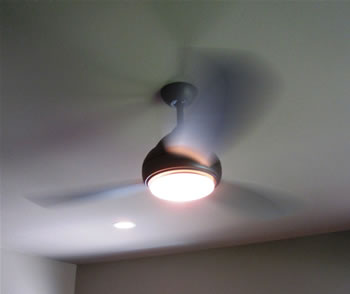Ceiling fans are used by many to help reduce the electricity costs associated with heating or cooling a home. By circulating the air in the room, both warm and cool air can be more evenly distributed. Ceiling fans have the power to reduce the body temperature during the warm months, allowing for the thermostat to be adjusted accordingly. Though the benefits of their use are quite clear, much is to be learned about the ceiling fan.
 Ceiling Fan Myths
Ceiling Fan Myths
- Ceiling fans will cool a room. Leaving a ceiling fan running in an empty room will not alter the room temperature. Fans only work to change body temperature through air, and will only result in wasted electricity when left running in an empty room.
- Ceiling fans have the power to cut off an appendage...even your head. High powered industrial fans with metal blades may indeed be able to accomplish this, but the standard fan for home use cannot. Do not test this on your own, however, as cuts, scrapes, bruises, and possibly a skull fracture could be the result.
- Ceiling fans are a relatively new invention. Not true. They actually date all the way back to the 1860's. The blades were spun using belts that were "powered" by moving water. Over the years the fan would meet electricity, but the basic premise would remain the same.
All ceiling fans are made up of several parts including:
- Electric motor
- Blades
- Ceiling mount
- Downrod
- Motor housing
- Light fixture (optional)
Potential Ceiling Fan Problems
There are a number of problems, some more serious than others, associated with the use of ceiling fans. Consider the following facts in order to avoid problems.
- Ceiling fans that are not properly installed can fall and cause injury or death. Though we'd all love to assume that this will never happen, it could if the electrical junction box is the wrong size. Problems may occur when switching an old fan out for a new one. Make sure that the correct box is used
- Wobbling does not mean the fan is going to fall. Wobbling does mean that there is likely a problem with the blade. A number of factors could cause them to become unstable and unbalanced. Proper balance is the key to eliminating wobbling
- Fans should never be installed in low-lying ceilings. The fan must be higher than 7 feet from floor level. Fans should also not be installed close to walls, but should be somewhat centered in the room
- If the blades turn in the wrong direction, you will not achieve the desired effect. Fans should create an updraft during the winter months so that heat can be more evenly distributed. During the summer months, a downdraft will be needed to direct a breeze to those in the room. Most modern ceiling fans allow the direction to be changed with just the flip of a switch


